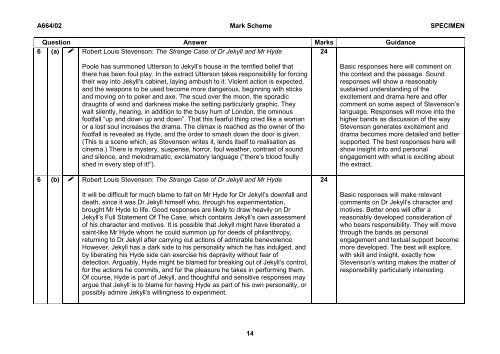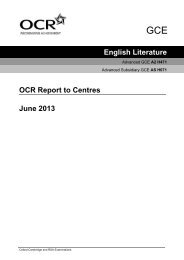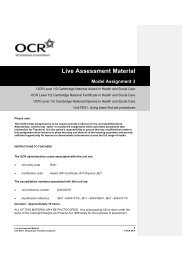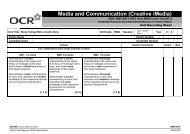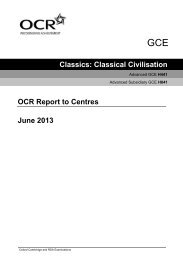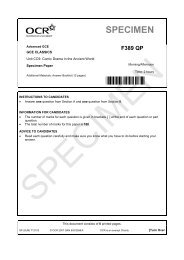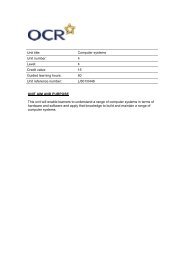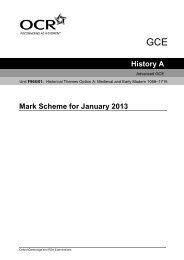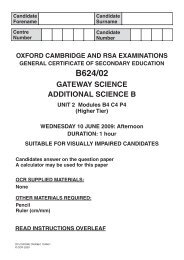Higher - From September 2013 - Specimen - OCR
Higher - From September 2013 - Specimen - OCR
Higher - From September 2013 - Specimen - OCR
Create successful ePaper yourself
Turn your PDF publications into a flip-book with our unique Google optimized e-Paper software.
A664/02 Mark Scheme SPECIMEN<br />
Question Answer Marks Guidance<br />
6 (a) Robert Louis Stevenson: The Strange Case of Dr Jekyll and Mr Hyde<br />
24<br />
Poole has summoned Utterson to Jekyll’s house in the terrified belief that<br />
there has been foul play. In the extract Utterson takes responsibility for forcing<br />
their way into Jekyll’s cabinet, laying ambush to it. Violent action is expected,<br />
and the weapons to be used become more dangerous, beginning with sticks<br />
and moving on to poker and axe. The scud over the moon, the sporadic<br />
draughts of wind and darkness make the setting particularly graphic. They<br />
wait silently, hearing, in addition to the busy hum of London, the ominous<br />
footfall “up and down up and down”. That this fearful thing cried like a woman<br />
or a lost soul increases the drama. The climax is reached as the owner of the<br />
footfall is revealed as Hyde, and the order to smash down the door is given.<br />
(This is a scene which, as Stevenson writes it, lends itself to realisation as<br />
cinema.) There is mystery, suspense, horror, foul weather, contrast of sound<br />
and silence, and melodramatic, exclamatory language (“there’s blood foully<br />
shed in every step of it!”).<br />
Basic responses here will comment on<br />
the context and the passage. Sound<br />
responses will show a reasonably<br />
sustained understanding of the<br />
excitement and drama here and offer<br />
comment on some aspect of Stevenson’s<br />
language. Responses will move into the<br />
higher bands as discussion of the way<br />
Stevenson generates excitement and<br />
drama becomes more detailed and better<br />
supported. The best responses here will<br />
show insight into and personal<br />
engagement with what is exciting about<br />
the extract.<br />
6 (b) Robert Louis Stevenson: The Strange Case of Dr Jekyll and Mr Hyde<br />
24<br />
It will be difficult for much blame to fall on Mr Hyde for Dr Jekyll’s downfall and<br />
death, since it was Dr Jekyll himself who, through his experimentation,<br />
brought Mr Hyde to life. Good responses are likely to draw heavily on Dr<br />
Jekyll’s Full Statement Of The Case, which contains Jekyll’s own assessment<br />
of his character and motives. It is possible that Jekyll might have liberated a<br />
saint-like Mr Hyde whom he could summon up for deeds of philanthropy,<br />
returning to Dr Jekyll after carrying out actions of admirable benevolence.<br />
However, Jekyll has a dark side to his personality which he has indulged, and<br />
by liberating his Hyde side can exercise his depravity without fear of<br />
detection. Arguably, Hyde might be blamed for breaking out of Jekyll’s control,<br />
for the actions he commits, and for the pleasure he takes in performing them.<br />
Of course, Hyde is part of Jekyll, and thoughtful and sensitive responses may<br />
argue that Jekyll is to blame for having Hyde as part of his own personality, or<br />
possibly admire Jekyll’s willingness to experiment.<br />
Basic responses will make relevant<br />
comments on Dr Jekyll’s character and<br />
motives. Better ones will offer a<br />
reasonably developed consideration of<br />
who bears responsibility. They will move<br />
through the bands as personal<br />
engagement and textual support become<br />
more developed. The best will explore,<br />
with skill and insight, exactly how<br />
Stevenson’s writing makes the matter of<br />
responsibility particularly interesting.<br />
14


